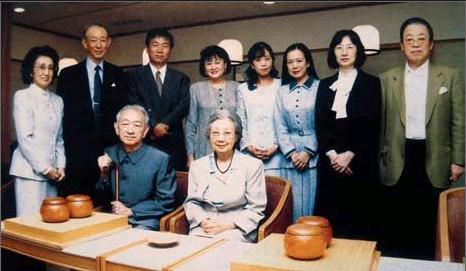“棋圣”吴清源祖籍地在石门
2014-01-16叶瑜荪
叶瑜荪

“琴、棋、书、画”是中国古代的四大艺术,而围棋则是各种棋类的鼻祖,相传已有几千年历史。战国时期就有“尧造围棋,朱丹善之”的记载。
吴清源是20世纪的围棋天才,被围棋界尊为“围棋之神”。
吴清源是中国围棋文化史上“七大奇才”中唯一还健在的一个。受父亲影响,吴清源自幼痴迷围棋,七八岁时就显露出“围棋神童”天赋。11岁时,天才少年吴清源的故事已广为人知,段祺瑞为其取字“清源”。他逐个战胜了国内围棋名手和访华的日本棋士,在中日棋坛引起惊愕和关注。
1928年10月,15岁的吴清源在众多中日友好人士帮助下,冲破重重困难,肩负中日围棋事业的进步和中日和睦的使命,被接往东京,成为日本著名棋士濑越宪作的弟子。从此,吴清源成为职业棋士。从“二战”前至战后的十番棋比赛中,他
一个一个地击败了当时名震棋坛的日本一流棋手,被奉为“当代棋圣”。
1914年6月12日,吴清源出生于福州,排行老三,取名泉。同年,全家迁到北京,他在北京度过了童年和少年时代。
如今,吴清源定居日本,已是百岁老人。他的大哥吴浣1979年移居美国,与儿子们一起生活,1994年逝世。二哥吴炎定居天津,亦已故世。然而,不管身居何处,他们一家从未忘记自己的祖籍地—浙江石门。他们都声称自己是“石门吴家”的后代。
那么,吴清源祖籍地的“石门吴家”,究竟在哪里呢?
1990年,移居美国加利福尼亚的吴清源堂弟吴翀,与在北京的弟弟吴硕合作,利用祖上留下的一份吴家族系图及有关资料,开始联络散居世界各地的亲戚,并搜索和查阅各种资料,终于在1997年编成了中、英文版的《吴氏家谱》一书。
日本学者桐山桂一所著《吴清源与他的兄弟 —吴家百年史》一书的中译本已于2005年11月由北京中信出版社出版。该书所引用《吴氏家谱》中有关“石门吴家”的史料,为我们查找吴清源的祖籍地提供了很多重要信息。
据《吴清源与他的兄弟 —吴家百年史》记述:“这一脉族系可以追溯到浙江省崇德。崇德附近有一个叫石门的地方,所以吴家好像又叫‘石门吴家。”吴清源的曾祖父吴渶是吴氏石门移居福州的第一人,也是石门吴氏福州支系的始祖。
关于“石门吴家”的来历,书中也有记述:北宋灭亡后,宋室南渡。“居住在开封的吴姓一族也跟着向南迁移,在现在的浙江省嘉兴定居下来。不久,这一族中的一部分人又移居到嘉兴西南约35公里处的崇德,他们就是‘石门吴家。”南宋时的崇德县,大致包括了今天桐乡市的范围。吴家沿运河从嘉兴迁到崇德县石门镇(亦称石门湾、石湾),正是35公里的距离。
“‘石门吴家非常重视教育,是真正的书香门第。”“他们的子孙中出现了一位为国家做出特殊贡献的法学家,受到清朝第四代皇帝康熙的青睐,御赐‘慎行二字。这份荣耀一直传到现在。”即石门吴家“慎行堂”。
能得到康熙亲书“慎行”二字的人叫吴涵,新编《桐乡县志》中即有收录。他于清康熙二年(1663)考取秀才,康熙二十一年(1682)高中“进士及第”,为榜眼。授翰林院编修,升顺天府丞、工部侍郎,转刑部,因审案公允,受康熙赏识,赐“慎行”二字,他便制作了“慎行堂”匾额。吴涵最后升左都御史。“慎行堂”堂名为我们查找吴涵一族的居住地提供了重要线索。
现居北京,以“柳江”“乐亭”“颐和园”等长卷图闻名的国画家吴蓬先生就是“慎行堂”的后人。他说从小就知道石门老家的堂名叫“慎行堂”,而且石门这一族的十几户吴姓都居“慎行堂”。虽然老宅已拆掉,但带有“慎行堂”记号的旧家具尚有部分保留在石门家中。笔者见到一对茶几椅子背面,有“光绪三十年置,慎行堂吴南山记”两行字。吴蓬说,这是1904年(光绪三十年)曾祖父吴南山置办时写上的。
吴蓬的老家“慎行堂”,在石门镇下塘,大运河的湾头上,俗称吴家门,是石门吴氏聚居之地。“慎行堂”吴氏后人,一部分世代务农,一部分亦农亦商。
最近,笔者重访了吴家门,了解到目前留在石门的“慎行堂”吴氏,婚丧素事来往的共有23户,百余人。追溯上去,大概是由四个支系繁衍发展而来。1971年大运河拓宽时,老宅拆迁,发现了很多家谱等家族资料,因时在“文革”中,未敢保留而全部毁弃了。
由于资料散失,石门“慎行堂”吴氏的历史原貌尚难完全理清。但有两点已可确定:一是吴清源家的福州吴氏是180多年前由石门“慎行堂”吴氏分迁过去,石门是吴清源家族的祖籍地;二是吴清源、吴蓬均是300多年前吴涵“慎行堂”的后人。
吴清源围棋分馆建在福州乌山南麓,占地约12 0 0平方米,整体为明清建筑风格。吴清源祖父吴维贞(1831 —1903)的墓地在福州南面的高盖山。为了不忘祖籍,墓碑上特地刻上了吴氏一族曾经生活过的浙江石门的地名。2004年,吴维贞墓已被列为福州历史文物而得到保护。此举保留了福州吴氏与石门祖籍地关系的一条重要历史证据。
浙江石门历史久远,名人辈出,对吴清源祖籍地的探源,彰显浙江乃人文荟萃的文献之邦。
Wu Qingyuan and his wife and Wus second elder brother Wu Yan visit Zhongshan Park in Beijing in Novem-ber 2002.
Tracing the Ancestry of the Father of Modern ‘Go
By Ye Yusun
In the history of the game of Go (Weiqi) that dates back at least 4,000 years ago in the Warring States period of China, the most dazzling star is Wu Qingyuan, widely recog-nized as a Go prodigy when he was a child and the ‘God of Go after he grew up.
Generally known in the West by his Japa-nese name Go Seigen, Wu Qingyuan is con-sidered by many to be the greatest player of the game of Go in the 20th century. The leg-end is also the only living Go master among the ‘Top 7 Go Players of China.
Born in 1914 in Fuzhou, Fujian Province, as the third child of the family, Wu Qingyuan started learning the game of Go at a relatively late age for a professional. In the year he was born, the whole family moved to Beijing, where Wu Qingyuan spent his childhood and adolescent years. His father, who had taken Go lessons from Honinbo Shuho while studying in Japan, introduced the boy to the game. The
boy quickly excelled and soon proved himself
a Go prodigy. Turning 11, he was already a player of professional strength, as evidenced by his games against China's top-ranking Go masters and visiting Japanese players.
After twice defeating a Japanese Go mas-ter player at the age of 14, Wu Qingyuans reputation spread to Japan, then the world's leading Go powerhouse. He subsequently im-migrated to Japan in 1928, at the invitation of Baron Kihachiro Okura and Inukai Tsuyoshi (later prime minister of Japan), and embarked on a professional career, under the tutorage of the famed Go player Segoe Kensaku. By the time he was 18 he was already a heavyweight player belonging to a very small elite.
Starting in 1939, Wu Qingyuan began a spectacular series of Jubango matches against other top players of his time. It was through these matches that Wu Qingyuan convincing-ly demonstrated an overwhelming dominance over his contemporaries. His star began to fade in the early 1960s due to health reasons and he had to virtually retire from professional Go-playing by 1964. However, the man remained ac-tive in the Go community through teaching, writing, and promoting Go around the world.
The centenarian now lives in Japan. His eldest brother Wu Huan moved to the US in 1979 to live with his sons, and passed away in 1994. His second eldest brother Wu Yan lived and rested in peace in Tianjin.
For a long time, the ancestry of the Wu family remained a mystery for genealogists. Some claim that ancestral roots of the Wu clan can be traced to Shimen, a small town in the north of Zhejiang province.
brother Wu Shuo, initiated a root-searching project in 1990. Relatives living in the four
corners of the world joined the inquiry that took seven years to finish. Genealogy of the
Wu Family was editorially completed in both Chinese and English in 1997.
The Chinese version translated from a book written by a Japanese scholar and pub-lished in 2005 provides a lot of vital hints about the mysterious ancestry of Wu Qingy-uan. According to the book, the family tree of the Go master originated in a place called Chongde in today's Zhejiang province and a nearby place called Shimen is closely related to the Wu family. The great grandfather of Wu Qingyuan is believed to be the first im-migrant in Fuzhou from Shimen and is the earliest ancestor of the later Wu generations in Fuzhou.
The legendary extended Wu family in Shimen is a truly scholar-gentry clan. One of the descendants was a preeminent jurist whose former residence in Shimen was bestowed an inscribed plaque by Emperor Kangxi. Called ‘Prudence, the plaque epito-mizes the glory and prestige of the Wu clan during the past century and implies convinc-ing clues about the ancestry of the family.
One of the representatives of the progeny of the Wu family living in modern times of China is Wu Peng, a famous traditional Chi-nese landscape painting artist now living in Beijing. The man knew from his childhood that the ancestral home of his family bears the same name and the emperors recogni-tion can still be found in the inscriptions on many old furniture pieces, although the old house in Shimen has been pulled down.
It has been confirmed that the ‘Prudence residence is in todays Shimen Town, just at the tip of the canal, and is referred to by the lo-cals as Wujiamen (the gate of the Wu family).
Due to lack of documentation, it is diffi-cult to find all the pieces for the ancestral jig-saw puzzle. However, compelling evidence has emerged for genealogists to reach the conclusion that the Wu progeny in today's Fuzhou is a bifurcation from the ‘Prudence clan and that Shimen is indeed the ancestral root of Wu Qingyuan.
Tucked away at the southern foot of the Wushan Hill in Fuzhou, Wu Qingyuan ‘Go Museum is a Ming- and Qing-style complex that covers about 1,200 sq.m. Wu Weizhen, the grandfather of the ‘Go master, is buried in Gaogai Mountain in the south of Fuzhou. On his tombstone is the name of Shimen in-dicating where he was from.
